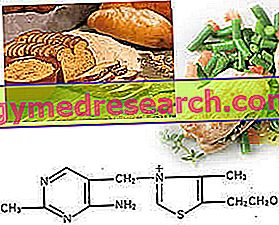Chemical Structure

Chemically thiamine consists of a derivative of pyrimidine and of thiazole linked by a methylene group.
Thiamine is phosphorylated in vivo to obtain mono-di- and tri-phosphate, thiamine pyrophosphate (TPP) is the biologically active form.
Absorption, Transport and Metabolism
Thiamine is absorbed in the proximal part of the small intestine for active and specific transport at low concentrations (<2 mg / l), while at higher concentrations for passive diffusion.
Excessive use of alcoholic beverages increases the rate of intestinal alcohol that inhibits absorption.
In the adult there are on average about 30 mg of thiamine contained in the heart, kidneys, liver, brain and skeletal muscles (which contain the lowest altitude, but given the mass they contain about 40% of the total).
The phosphorylation of thiamine at TPP occurs in all tissues and mainly in the liver.
Thiamine in excess of needs is rapidly eliminated in the urine as such or degraded.
Thiamine functions
Thiamine is enzymatically phosphorylated to TPP from thiamine-pyrophosphate synthetase which transfers a pyrophosphate from ATP to the hydroxyl group of thiamine.
TPP intervenes in the reactions of oxidative decarboxylation of α-keto acids and in transketulation reactions.
The TPP dependent enzymes are:
- the pyruvic dehydrogenase that converts pyruvic acid to acetyl-CoA;
- the α-ketoglutaric - dehydrogenase that transforms α-ketoglutarate into succinyl CoA;
- the dehydrogenase of branched chain α-keto acids, which transforms these last into the corresponding acA CoA.
Oxidative decarboxylation reactions occur only in the presence of coenzyme A, lipoic acid and NAD, in fact decarboxylase binds TPP, transacetylase binds lipoic acid and dependent FAD dehydrogenase regenerates reduced lipoic acid.
The transketolase present in the cytoplasm transfers a glycoaldehyde group from some α-ketozuccheri (xylulose 5-P, sedoeptuloso 7-P etc.) to C1 of some aldoses; acts in a reaction of the pentose phosphate pathway for glucose oxidation.
A role different from the coenzymatic one has been observed in nerve cells where the active form appears to be TTP; TTP would be hydrolyzed following a nervous stimulus and would modify the permeability of Cl ˉ channels.
Deficiency and toxicity
Thiamine deficiency mainly affects the digestive, cardio-circulatory and nervous systems; the symptoms vary subjectively, also depending on the diet but generally they are always present.
The overt deficiency of thiamine determines the beriberi that can manifest itself in three different forms:
- dry or neuritic beriberi;
- wet beriberi edematous;
- cerebral beriberi.
Before assuming a precise physiognomy, this disease manifests itself with loss of appetite, asthenia, gastrointestinal disorders, edema (sometimes), sensitivity disorders, uncertainty in movements, pain and muscle spasms.
Dry beriberi is characterized by polyneuritis, which begins with walking problems and evolves towards a flaccid, symmetrical paralysis, especially in the lower limbs, with complications of muscular atrophy and disappearance of tendon reflexes; the cardiovascular alterations are quite frequent but of little entity.
In wet beriberi, cardiovascular and respiratory symptoms with tachycardia, exertional dyspnea, palpitations prevail, followed by homogeneous cardiomegaly (radiological investigation) and specific signs of cardiac failure may occur in the form of edema; cardiac impairment can cause sudden death.
Brainbere is the most common form in industrialized countries associated with abuse of alcoholic beverages (Wernicke-Korsakoff syndrome or Wernicke's encephalopathy). It is characterized by psychic signs (temporal space disorientation, apathy, confusion, torpor), neurological manifestations (ophthalmoplegia, ataxia, nystagmus) and is often associated with polyneuropathy.
Beriberi can also occur in infants (2 ÷ 6 months of life), especially if breast-fed by thiamine-deficient mothers, with anorexia, vomiting, diarrhea, sleep disorders, cyanosis, tachycardia, convulsions. It has a fulminant course, due to heart failure, if action is not taken quickly with adequate treatment.
Thiamine toxicity is very low, oral doses up to 500 mg / day for a month are well tolerated, as well as 100 mg parenteral, higher doses can cause headaches, convulsions, weakness, cardiac arrhythmia and allergic reactions.
In animal and plant tissues, two thiamine antagonist enzymes have been discovered: thiaminase I and thiaminase II.
Thiaminase I is responsible for some cases of hypovitaminosis in countries where raw fish is consumed and Chastek's paralysis, which affects minks and foxes fed on animal viscera.
Thiaminase II, produced mainly by intestinal bacteria, may also cause hypovitaminosis in some cases.
Feeders and recommended ration
Thiamine is widely distributed in foods, but most contain only small amounts.
Good bearers are: meat, in particular pork; offal; the eggs; cereals, which are the main source and dry legumes for many populations.
Whole grains are richer in thiamine as they concentrate mainly in the pericarp and in the peri-sperm of the caryopsis which are eliminated during grinding and sifting.
In parboiled rice the thiamine content is higher than in polished rice, because before refining it is subjected to a technological process that allows the transfer of the vitamin from the outer layers towards the endosperm.
Since the main role of thiamine concerns energy metabolism and in particular that of carbohydrates, bearing in mind the difficulty of reaching the recommended ration, the latter is referred to the energy intake and more precisely to 1, 000 kcal of the ration.
According to the LARN the recommended ration is 0.4 mg / 1, 000 kcal, with the recommendation not to fall below 0.8 mg in the adult with an energy intake lower than 2.000 kcal / day.



